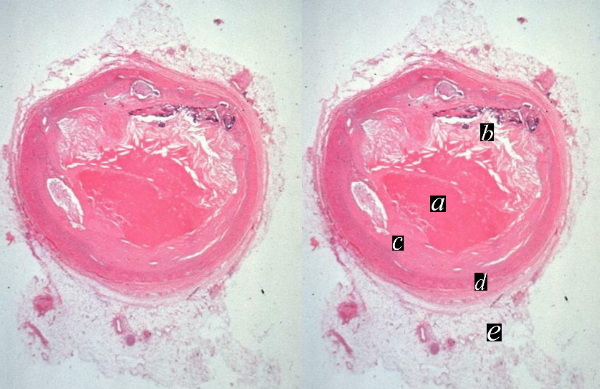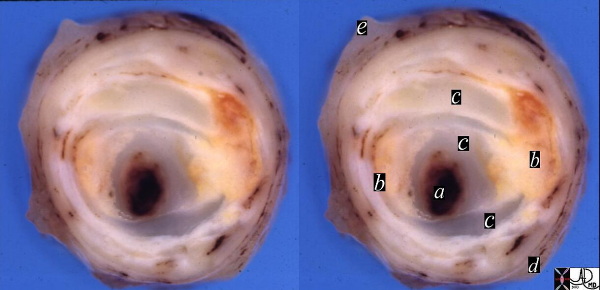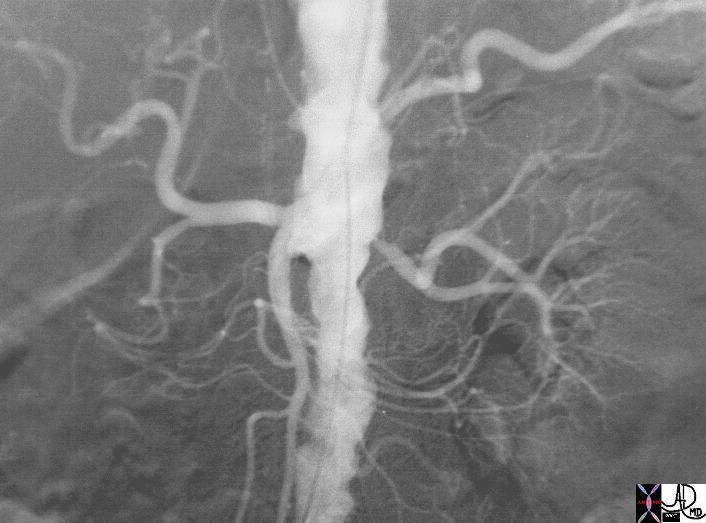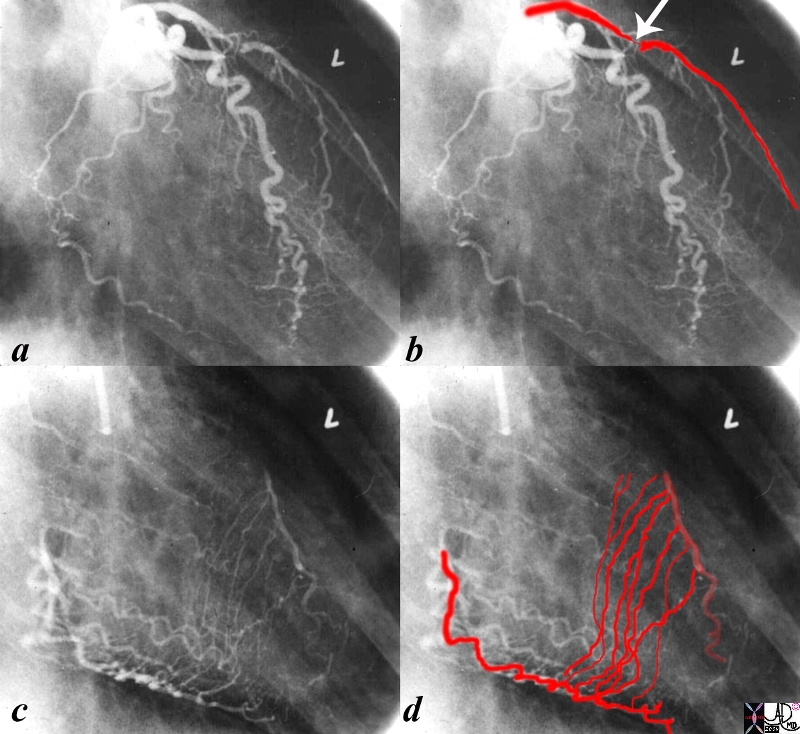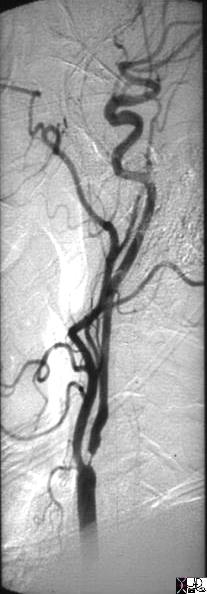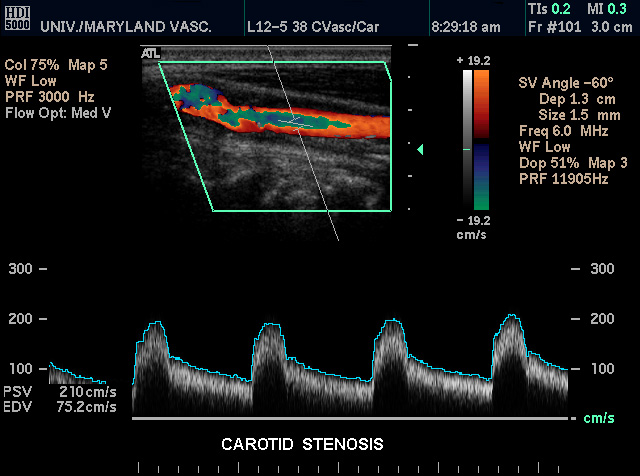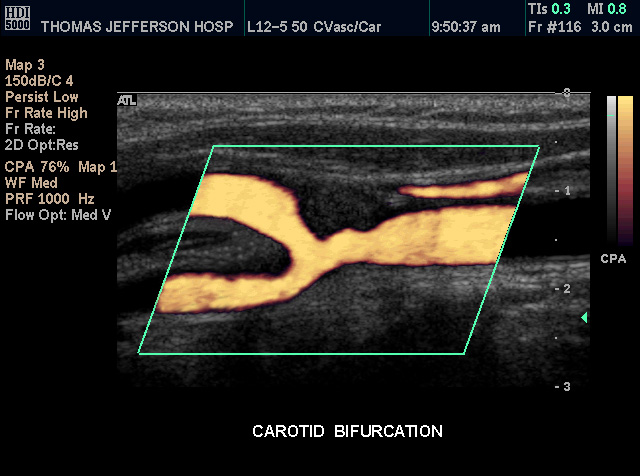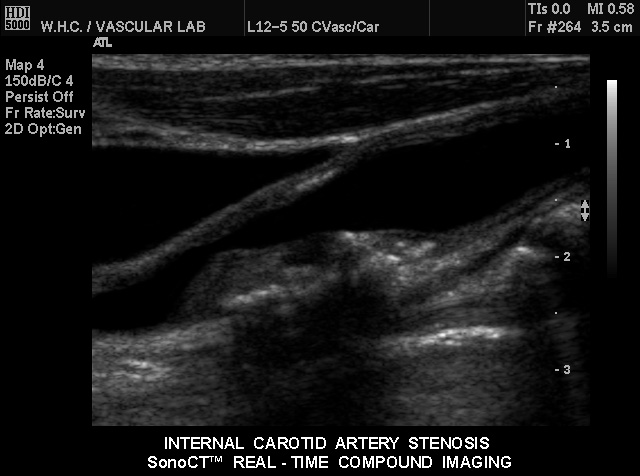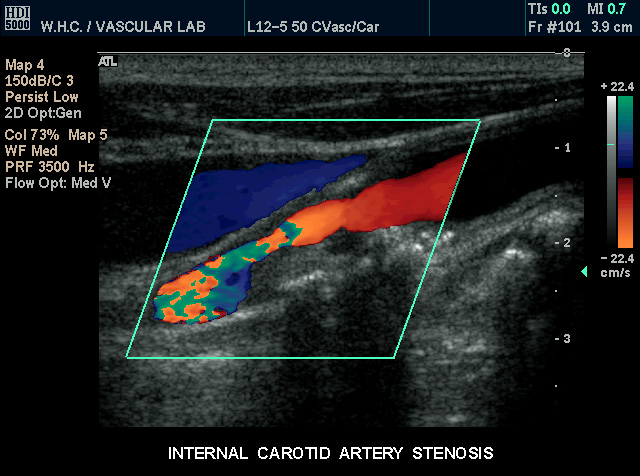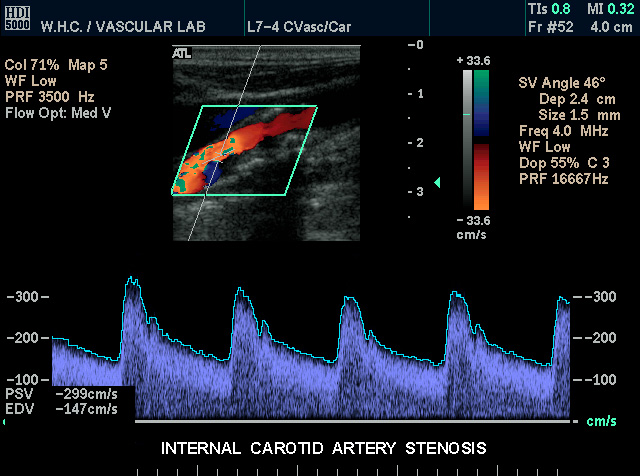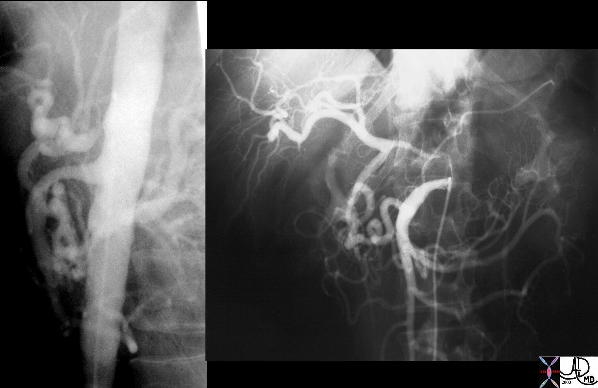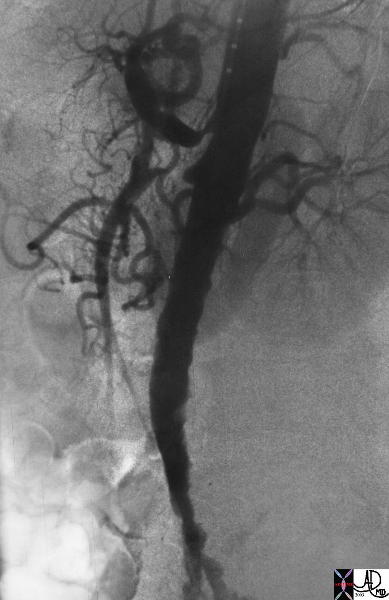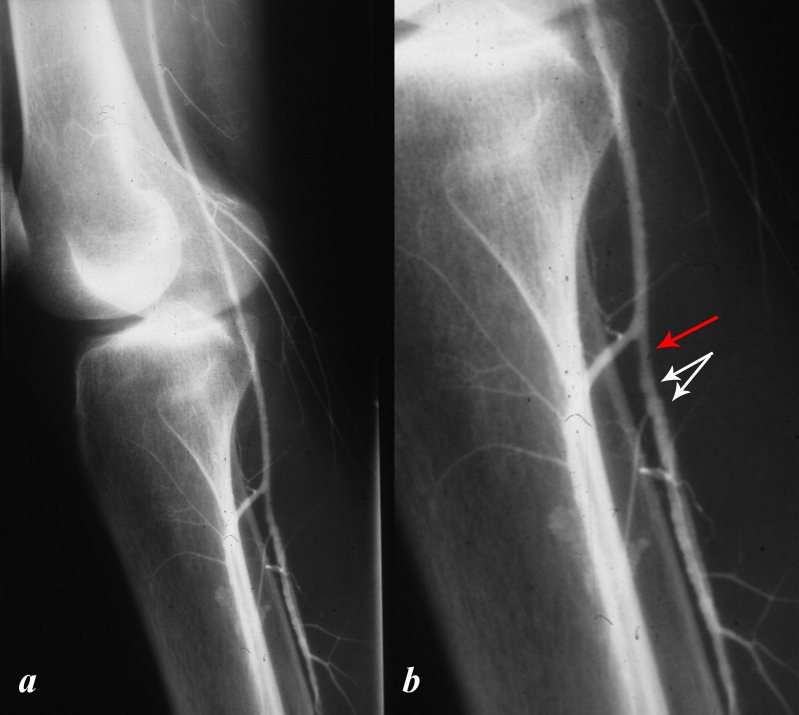Arterial Stenosis
Ashley Davidoff MD
Copyright 2012
Introduction
Atherosclerosis
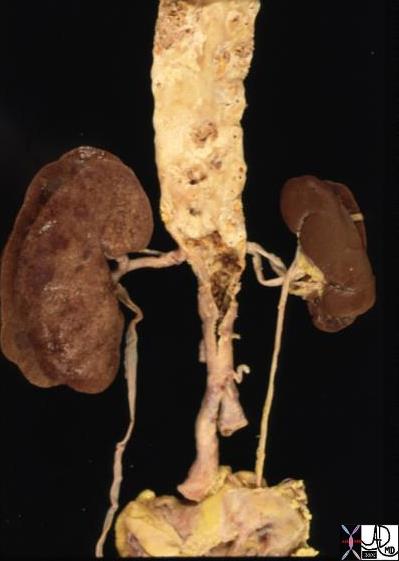
Stenosis of the Left Renal Artery |
|
aorta abdomen iliac artery fx atherosclerosis kidney fx small dx RAS renal artery stenosis grosspathology Copyright 2012 Courtesy Ashley Davidoff MD 13417 |

Stenosis of the Right Coronary Artery |
|
cardiac heart coronary artery RCA RAO PDA moderate stenosis angiogram angiography Copyright 2012 Courtesy Ashley Davidoff MD 15024 |

Color Flow Doppler of a Common Carotid Stenosis |
|
Patient with carotid artery stenosis demonstrated by color flow doppler. Courtesy Philips Medical Systems 33278 |

Graft Stenosis |
|
In situ graft stenosis of an artery by compound US. Courtesy Philips Medical Systems 33237 33242 |

Doppler – High Grade Stenosis |
|
Graft stenosis shown by color doppler and high velocity pulse doppler US waves are shown at the stenotic site. Courtesy Philips Medical Systems 33243 |
|
Narrowing of vessel Caused by Traumatic Spasm |
| This male patient presented with transient loss of pulses and cyanosis of the right foot following traumatic injury to his knee. This angiogram of the popliteal artery, (a, and magnified in b) show spasm and narrowing (red arrow) of the tibioperoneal trunk as well as beading of the artery (white arrows). No obvious intimal injury is identified.
Copyright 2012 Courtesy Ashley Davidoff MD 00008c01.8L |
DOMElement Object
(
[schemaTypeInfo] =>
[tagName] => table
[firstElementChild] => (object value omitted)
[lastElementChild] => (object value omitted)
[childElementCount] => 1
[previousElementSibling] => (object value omitted)
[nextElementSibling] =>
[nodeName] => table
[nodeValue] =>
Narrowing of vessel Caused by Traumatic Spasm
This male patient presented with transient loss of pulses and cyanosis of the right foot following traumatic injury to his knee. This angiogram of the popliteal artery, (a, and magnified in b) show spasm and narrowing (red arrow) of the tibioperoneal trunk as well as beading of the artery (white arrows). No obvious intimal injury is identified.
Copyright 2012 Courtesy Ashley Davidoff MD 00008c01.8L
[nodeType] => 1
[parentNode] => (object value omitted)
[childNodes] => (object value omitted)
[firstChild] => (object value omitted)
[lastChild] => (object value omitted)
[previousSibling] => (object value omitted)
[nextSibling] => (object value omitted)
[attributes] => (object value omitted)
[ownerDocument] => (object value omitted)
[namespaceURI] =>
[prefix] =>
[localName] => table
[baseURI] =>
[textContent] =>
Narrowing of vessel Caused by Traumatic Spasm
This male patient presented with transient loss of pulses and cyanosis of the right foot following traumatic injury to his knee. This angiogram of the popliteal artery, (a, and magnified in b) show spasm and narrowing (red arrow) of the tibioperoneal trunk as well as beading of the artery (white arrows). No obvious intimal injury is identified.
Copyright 2012 Courtesy Ashley Davidoff MD 00008c01.8L
)
DOMElement Object
(
[schemaTypeInfo] =>
[tagName] => td
[firstElementChild] => (object value omitted)
[lastElementChild] => (object value omitted)
[childElementCount] => 1
[previousElementSibling] =>
[nextElementSibling] =>
[nodeName] => td
[nodeValue] => This male patient presented with transient loss of pulses and cyanosis of the right foot following traumatic injury to his knee. This angiogram of the popliteal artery, (a, and magnified in b) show spasm and narrowing (red arrow) of the tibioperoneal trunk as well as beading of the artery (white arrows). No obvious intimal injury is identified.
Copyright 2012 Courtesy Ashley Davidoff MD 00008c01.8L
[nodeType] => 1
[parentNode] => (object value omitted)
[childNodes] => (object value omitted)
[firstChild] => (object value omitted)
[lastChild] => (object value omitted)
[previousSibling] => (object value omitted)
[nextSibling] => (object value omitted)
[attributes] => (object value omitted)
[ownerDocument] => (object value omitted)
[namespaceURI] =>
[prefix] =>
[localName] => td
[baseURI] =>
[textContent] => This male patient presented with transient loss of pulses and cyanosis of the right foot following traumatic injury to his knee. This angiogram of the popliteal artery, (a, and magnified in b) show spasm and narrowing (red arrow) of the tibioperoneal trunk as well as beading of the artery (white arrows). No obvious intimal injury is identified.
Copyright 2012 Courtesy Ashley Davidoff MD 00008c01.8L
)
DOMElement Object
(
[schemaTypeInfo] =>
[tagName] => td
[firstElementChild] => (object value omitted)
[lastElementChild] => (object value omitted)
[childElementCount] => 2
[previousElementSibling] =>
[nextElementSibling] =>
[nodeName] => td
[nodeValue] =>
Narrowing of vessel Caused by Traumatic Spasm
[nodeType] => 1
[parentNode] => (object value omitted)
[childNodes] => (object value omitted)
[firstChild] => (object value omitted)
[lastChild] => (object value omitted)
[previousSibling] => (object value omitted)
[nextSibling] => (object value omitted)
[attributes] => (object value omitted)
[ownerDocument] => (object value omitted)
[namespaceURI] =>
[prefix] =>
[localName] => td
[baseURI] =>
[textContent] =>
Narrowing of vessel Caused by Traumatic Spasm
)
DOMElement Object
(
[schemaTypeInfo] =>
[tagName] => table
[firstElementChild] => (object value omitted)
[lastElementChild] => (object value omitted)
[childElementCount] => 1
[previousElementSibling] => (object value omitted)
[nextElementSibling] => (object value omitted)
[nodeName] => table
[nodeValue] =>
Celiac Axis Stenosis and Subtotal Occlusion of the SMA
The lateral projection of the digital angiogram shows mild to moderate infrarenal atherosclerosis characterised by luminal irregularity. There is also mild lumenal narrowing of the affected infrarenal segment. The suprarenal aorta is smooth and within normal limits. The celiac axis has a high grade sternosis and the SMA shows a subtotal occlusion.
Courtesy Laura Feldman MD. 35060 See also 35059
[nodeType] => 1
[parentNode] => (object value omitted)
[childNodes] => (object value omitted)
[firstChild] => (object value omitted)
[lastChild] => (object value omitted)
[previousSibling] => (object value omitted)
[nextSibling] => (object value omitted)
[attributes] => (object value omitted)
[ownerDocument] => (object value omitted)
[namespaceURI] =>
[prefix] =>
[localName] => table
[baseURI] =>
[textContent] =>
Celiac Axis Stenosis and Subtotal Occlusion of the SMA
The lateral projection of the digital angiogram shows mild to moderate infrarenal atherosclerosis characterised by luminal irregularity. There is also mild lumenal narrowing of the affected infrarenal segment. The suprarenal aorta is smooth and within normal limits. The celiac axis has a high grade sternosis and the SMA shows a subtotal occlusion.
Courtesy Laura Feldman MD. 35060 See also 35059
)
DOMElement Object
(
[schemaTypeInfo] =>
[tagName] => td
[firstElementChild] => (object value omitted)
[lastElementChild] => (object value omitted)
[childElementCount] => 2
[previousElementSibling] =>
[nextElementSibling] =>
[nodeName] => td
[nodeValue] =>
The lateral projection of the digital angiogram shows mild to moderate infrarenal atherosclerosis characterised by luminal irregularity. There is also mild lumenal narrowing of the affected infrarenal segment. The suprarenal aorta is smooth and within normal limits. The celiac axis has a high grade sternosis and the SMA shows a subtotal occlusion.
Courtesy Laura Feldman MD. 35060 See also 35059
[nodeType] => 1
[parentNode] => (object value omitted)
[childNodes] => (object value omitted)
[firstChild] => (object value omitted)
[lastChild] => (object value omitted)
[previousSibling] => (object value omitted)
[nextSibling] => (object value omitted)
[attributes] => (object value omitted)
[ownerDocument] => (object value omitted)
[namespaceURI] =>
[prefix] =>
[localName] => td
[baseURI] =>
[textContent] =>
The lateral projection of the digital angiogram shows mild to moderate infrarenal atherosclerosis characterised by luminal irregularity. There is also mild lumenal narrowing of the affected infrarenal segment. The suprarenal aorta is smooth and within normal limits. The celiac axis has a high grade sternosis and the SMA shows a subtotal occlusion.
Courtesy Laura Feldman MD. 35060 See also 35059
)
DOMElement Object
(
[schemaTypeInfo] =>
[tagName] => td
[firstElementChild] => (object value omitted)
[lastElementChild] => (object value omitted)
[childElementCount] => 2
[previousElementSibling] =>
[nextElementSibling] =>
[nodeName] => td
[nodeValue] =>
Celiac Axis Stenosis and Subtotal Occlusion of the SMA
[nodeType] => 1
[parentNode] => (object value omitted)
[childNodes] => (object value omitted)
[firstChild] => (object value omitted)
[lastChild] => (object value omitted)
[previousSibling] => (object value omitted)
[nextSibling] => (object value omitted)
[attributes] => (object value omitted)
[ownerDocument] => (object value omitted)
[namespaceURI] =>
[prefix] =>
[localName] => td
[baseURI] =>
[textContent] =>
Celiac Axis Stenosis and Subtotal Occlusion of the SMA
)
DOMElement Object
(
[schemaTypeInfo] =>
[tagName] => table
[firstElementChild] => (object value omitted)
[lastElementChild] => (object value omitted)
[childElementCount] => 1
[previousElementSibling] => (object value omitted)
[nextElementSibling] => (object value omitted)
[nodeName] => table
[nodeValue] =>
Long Segment Celiac Axis Stenosis with Collaterals from SMA
Angiogram of the SMA shows retrograde filling of the celiac axis which has a significant long segment stenosis. This stenosis has an unusual appearance in that it is relatively long but the most likely cause is atherosclerosis.
Courtesy Laura Feldman MD 35076c
[nodeType] => 1
[parentNode] => (object value omitted)
[childNodes] => (object value omitted)
[firstChild] => (object value omitted)
[lastChild] => (object value omitted)
[previousSibling] => (object value omitted)
[nextSibling] => (object value omitted)
[attributes] => (object value omitted)
[ownerDocument] => (object value omitted)
[namespaceURI] =>
[prefix] =>
[localName] => table
[baseURI] =>
[textContent] =>
Long Segment Celiac Axis Stenosis with Collaterals from SMA
Angiogram of the SMA shows retrograde filling of the celiac axis which has a significant long segment stenosis. This stenosis has an unusual appearance in that it is relatively long but the most likely cause is atherosclerosis.
Courtesy Laura Feldman MD 35076c
)
DOMElement Object
(
[schemaTypeInfo] =>
[tagName] => td
[firstElementChild] => (object value omitted)
[lastElementChild] => (object value omitted)
[childElementCount] => 2
[previousElementSibling] =>
[nextElementSibling] =>
[nodeName] => td
[nodeValue] =>
Angiogram of the SMA shows retrograde filling of the celiac axis which has a significant long segment stenosis. This stenosis has an unusual appearance in that it is relatively long but the most likely cause is atherosclerosis.
Courtesy Laura Feldman MD 35076c
[nodeType] => 1
[parentNode] => (object value omitted)
[childNodes] => (object value omitted)
[firstChild] => (object value omitted)
[lastChild] => (object value omitted)
[previousSibling] => (object value omitted)
[nextSibling] => (object value omitted)
[attributes] => (object value omitted)
[ownerDocument] => (object value omitted)
[namespaceURI] =>
[prefix] =>
[localName] => td
[baseURI] =>
[textContent] =>
Angiogram of the SMA shows retrograde filling of the celiac axis which has a significant long segment stenosis. This stenosis has an unusual appearance in that it is relatively long but the most likely cause is atherosclerosis.
Courtesy Laura Feldman MD 35076c
)
DOMElement Object
(
[schemaTypeInfo] =>
[tagName] => td
[firstElementChild] => (object value omitted)
[lastElementChild] => (object value omitted)
[childElementCount] => 2
[previousElementSibling] =>
[nextElementSibling] =>
[nodeName] => td
[nodeValue] =>
Long Segment Celiac Axis Stenosis with Collaterals from SMA
[nodeType] => 1
[parentNode] => (object value omitted)
[childNodes] => (object value omitted)
[firstChild] => (object value omitted)
[lastChild] => (object value omitted)
[previousSibling] => (object value omitted)
[nextSibling] => (object value omitted)
[attributes] => (object value omitted)
[ownerDocument] => (object value omitted)
[namespaceURI] =>
[prefix] =>
[localName] => td
[baseURI] =>
[textContent] =>
Long Segment Celiac Axis Stenosis with Collaterals from SMA
)
DOMElement Object
(
[schemaTypeInfo] =>
[tagName] => table
[firstElementChild] => (object value omitted)
[lastElementChild] => (object value omitted)
[childElementCount] => 1
[previousElementSibling] => (object value omitted)
[nextElementSibling] => (object value omitted)
[nodeName] => table
[nodeValue] =>
Evaluation of Pulse
This color flow doppler US and pulsed doppler interrogation of the neck shows an area of thickening and heaping up off the far wall of the of the internal carotid artery characteristic of atherosclerotic plaque. There is a moderate stenosis of the vessel.
Courtesy Philips Medical Systems. 33301
[nodeType] => 1
[parentNode] => (object value omitted)
[childNodes] => (object value omitted)
[firstChild] => (object value omitted)
[lastChild] => (object value omitted)
[previousSibling] => (object value omitted)
[nextSibling] => (object value omitted)
[attributes] => (object value omitted)
[ownerDocument] => (object value omitted)
[namespaceURI] =>
[prefix] =>
[localName] => table
[baseURI] =>
[textContent] =>
Evaluation of Pulse
This color flow doppler US and pulsed doppler interrogation of the neck shows an area of thickening and heaping up off the far wall of the of the internal carotid artery characteristic of atherosclerotic plaque. There is a moderate stenosis of the vessel.
Courtesy Philips Medical Systems. 33301
)
DOMElement Object
(
[schemaTypeInfo] =>
[tagName] => td
[firstElementChild] => (object value omitted)
[lastElementChild] => (object value omitted)
[childElementCount] => 1
[previousElementSibling] =>
[nextElementSibling] =>
[nodeName] => td
[nodeValue] => This color flow doppler US and pulsed doppler interrogation of the neck shows an area of thickening and heaping up off the far wall of the of the internal carotid artery characteristic of atherosclerotic plaque. There is a moderate stenosis of the vessel.
Courtesy Philips Medical Systems. 33301
[nodeType] => 1
[parentNode] => (object value omitted)
[childNodes] => (object value omitted)
[firstChild] => (object value omitted)
[lastChild] => (object value omitted)
[previousSibling] => (object value omitted)
[nextSibling] => (object value omitted)
[attributes] => (object value omitted)
[ownerDocument] => (object value omitted)
[namespaceURI] =>
[prefix] =>
[localName] => td
[baseURI] =>
[textContent] => This color flow doppler US and pulsed doppler interrogation of the neck shows an area of thickening and heaping up off the far wall of the of the internal carotid artery characteristic of atherosclerotic plaque. There is a moderate stenosis of the vessel.
Courtesy Philips Medical Systems. 33301
)
DOMElement Object
(
[schemaTypeInfo] =>
[tagName] => td
[firstElementChild] => (object value omitted)
[lastElementChild] => (object value omitted)
[childElementCount] => 2
[previousElementSibling] =>
[nextElementSibling] =>
[nodeName] => td
[nodeValue] =>
Evaluation of Pulse
[nodeType] => 1
[parentNode] => (object value omitted)
[childNodes] => (object value omitted)
[firstChild] => (object value omitted)
[lastChild] => (object value omitted)
[previousSibling] => (object value omitted)
[nextSibling] => (object value omitted)
[attributes] => (object value omitted)
[ownerDocument] => (object value omitted)
[namespaceURI] =>
[prefix] =>
[localName] => td
[baseURI] =>
[textContent] =>
Evaluation of Pulse
)
DOMElement Object
(
[schemaTypeInfo] =>
[tagName] => table
[firstElementChild] => (object value omitted)
[lastElementChild] => (object value omitted)
[childElementCount] => 1
[previousElementSibling] => (object value omitted)
[nextElementSibling] => (object value omitted)
[nodeName] => table
[nodeValue] =>
Power Doppler of Internal carotid Atherosclerotic Stenosis
This power flow doppler US of the neck shows an area of thickening and heaping up off the near wall of the of the internal carotid artery characteristic of atherosclerotic plaque. There is a moderately severe stenosis of the vessel.
Courtesy Philips Medical Systems. 33304
[nodeType] => 1
[parentNode] => (object value omitted)
[childNodes] => (object value omitted)
[firstChild] => (object value omitted)
[lastChild] => (object value omitted)
[previousSibling] => (object value omitted)
[nextSibling] => (object value omitted)
[attributes] => (object value omitted)
[ownerDocument] => (object value omitted)
[namespaceURI] =>
[prefix] =>
[localName] => table
[baseURI] =>
[textContent] =>
Power Doppler of Internal carotid Atherosclerotic Stenosis
This power flow doppler US of the neck shows an area of thickening and heaping up off the near wall of the of the internal carotid artery characteristic of atherosclerotic plaque. There is a moderately severe stenosis of the vessel.
Courtesy Philips Medical Systems. 33304
)
DOMElement Object
(
[schemaTypeInfo] =>
[tagName] => td
[firstElementChild] => (object value omitted)
[lastElementChild] => (object value omitted)
[childElementCount] => 2
[previousElementSibling] =>
[nextElementSibling] =>
[nodeName] => td
[nodeValue] =>
This power flow doppler US of the neck shows an area of thickening and heaping up off the near wall of the of the internal carotid artery characteristic of atherosclerotic plaque. There is a moderately severe stenosis of the vessel.
Courtesy Philips Medical Systems. 33304
[nodeType] => 1
[parentNode] => (object value omitted)
[childNodes] => (object value omitted)
[firstChild] => (object value omitted)
[lastChild] => (object value omitted)
[previousSibling] => (object value omitted)
[nextSibling] => (object value omitted)
[attributes] => (object value omitted)
[ownerDocument] => (object value omitted)
[namespaceURI] =>
[prefix] =>
[localName] => td
[baseURI] =>
[textContent] =>
This power flow doppler US of the neck shows an area of thickening and heaping up off the near wall of the of the internal carotid artery characteristic of atherosclerotic plaque. There is a moderately severe stenosis of the vessel.
Courtesy Philips Medical Systems. 33304
)
DOMElement Object
(
[schemaTypeInfo] =>
[tagName] => td
[firstElementChild] => (object value omitted)
[lastElementChild] => (object value omitted)
[childElementCount] => 2
[previousElementSibling] =>
[nextElementSibling] =>
[nodeName] => td
[nodeValue] =>
Power Doppler of Internal carotid Atherosclerotic Stenosis
[nodeType] => 1
[parentNode] => (object value omitted)
[childNodes] => (object value omitted)
[firstChild] => (object value omitted)
[lastChild] => (object value omitted)
[previousSibling] => (object value omitted)
[nextSibling] => (object value omitted)
[attributes] => (object value omitted)
[ownerDocument] => (object value omitted)
[namespaceURI] =>
[prefix] =>
[localName] => td
[baseURI] =>
[textContent] =>
Power Doppler of Internal carotid Atherosclerotic Stenosis
)
DOMElement Object
(
[schemaTypeInfo] =>
[tagName] => table
[firstElementChild] => (object value omitted)
[lastElementChild] => (object value omitted)
[childElementCount] => 1
[previousElementSibling] => (object value omitted)
[nextElementSibling] => (object value omitted)
[nodeName] => table
[nodeValue] =>
Color Flow Doppler of Stenotic Plaque
This color flow doppler US of the neck shows an area of thickening and heaping up off the near wall of the of the internal carotid artery characteristic of atherosclerotic plaque. There is a moderately severe stenosis of the vessel.
Courtesy Philips Medical Systems. 33302
[nodeType] => 1
[parentNode] => (object value omitted)
[childNodes] => (object value omitted)
[firstChild] => (object value omitted)
[lastChild] => (object value omitted)
[previousSibling] => (object value omitted)
[nextSibling] => (object value omitted)
[attributes] => (object value omitted)
[ownerDocument] => (object value omitted)
[namespaceURI] =>
[prefix] =>
[localName] => table
[baseURI] =>
[textContent] =>
Color Flow Doppler of Stenotic Plaque
This color flow doppler US of the neck shows an area of thickening and heaping up off the near wall of the of the internal carotid artery characteristic of atherosclerotic plaque. There is a moderately severe stenosis of the vessel.
Courtesy Philips Medical Systems. 33302
)
DOMElement Object
(
[schemaTypeInfo] =>
[tagName] => td
[firstElementChild] => (object value omitted)
[lastElementChild] => (object value omitted)
[childElementCount] => 1
[previousElementSibling] =>
[nextElementSibling] =>
[nodeName] => td
[nodeValue] => This color flow doppler US of the neck shows an area of thickening and heaping up off the near wall of the of the internal carotid artery characteristic of atherosclerotic plaque. There is a moderately severe stenosis of the vessel.
Courtesy Philips Medical Systems. 33302
[nodeType] => 1
[parentNode] => (object value omitted)
[childNodes] => (object value omitted)
[firstChild] => (object value omitted)
[lastChild] => (object value omitted)
[previousSibling] => (object value omitted)
[nextSibling] => (object value omitted)
[attributes] => (object value omitted)
[ownerDocument] => (object value omitted)
[namespaceURI] =>
[prefix] =>
[localName] => td
[baseURI] =>
[textContent] => This color flow doppler US of the neck shows an area of thickening and heaping up off the near wall of the of the internal carotid artery characteristic of atherosclerotic plaque. There is a moderately severe stenosis of the vessel.
Courtesy Philips Medical Systems. 33302
)
DOMElement Object
(
[schemaTypeInfo] =>
[tagName] => td
[firstElementChild] => (object value omitted)
[lastElementChild] => (object value omitted)
[childElementCount] => 2
[previousElementSibling] =>
[nextElementSibling] =>
[nodeName] => td
[nodeValue] =>
Color Flow Doppler of Stenotic Plaque
[nodeType] => 1
[parentNode] => (object value omitted)
[childNodes] => (object value omitted)
[firstChild] => (object value omitted)
[lastChild] => (object value omitted)
[previousSibling] => (object value omitted)
[nextSibling] => (object value omitted)
[attributes] => (object value omitted)
[ownerDocument] => (object value omitted)
[namespaceURI] =>
[prefix] =>
[localName] => td
[baseURI] =>
[textContent] =>
Color Flow Doppler of Stenotic Plaque
)
DOMElement Object
(
[schemaTypeInfo] =>
[tagName] => table
[firstElementChild] => (object value omitted)
[lastElementChild] => (object value omitted)
[childElementCount] => 1
[previousElementSibling] => (object value omitted)
[nextElementSibling] => (object value omitted)
[nodeName] => table
[nodeValue] =>
Calcified Atherosclerotic Plaque
This gray scale US of the neck shows an area of thickening and heaping up off the far wall of the of the internal carotid artery characteristic of atherosclerotic plaque. There is a moderate stenosis of the vessel.
Courtesy Philips Medical Systems. 33299
[nodeType] => 1
[parentNode] => (object value omitted)
[childNodes] => (object value omitted)
[firstChild] => (object value omitted)
[lastChild] => (object value omitted)
[previousSibling] => (object value omitted)
[nextSibling] => (object value omitted)
[attributes] => (object value omitted)
[ownerDocument] => (object value omitted)
[namespaceURI] =>
[prefix] =>
[localName] => table
[baseURI] =>
[textContent] =>
Calcified Atherosclerotic Plaque
This gray scale US of the neck shows an area of thickening and heaping up off the far wall of the of the internal carotid artery characteristic of atherosclerotic plaque. There is a moderate stenosis of the vessel.
Courtesy Philips Medical Systems. 33299
)
DOMElement Object
(
[schemaTypeInfo] =>
[tagName] => td
[firstElementChild] => (object value omitted)
[lastElementChild] => (object value omitted)
[childElementCount] => 2
[previousElementSibling] =>
[nextElementSibling] =>
[nodeName] => td
[nodeValue] =>
This gray scale US of the neck shows an area of thickening and heaping up off the far wall of the of the internal carotid artery characteristic of atherosclerotic plaque. There is a moderate stenosis of the vessel.
Courtesy Philips Medical Systems. 33299
[nodeType] => 1
[parentNode] => (object value omitted)
[childNodes] => (object value omitted)
[firstChild] => (object value omitted)
[lastChild] => (object value omitted)
[previousSibling] => (object value omitted)
[nextSibling] => (object value omitted)
[attributes] => (object value omitted)
[ownerDocument] => (object value omitted)
[namespaceURI] =>
[prefix] =>
[localName] => td
[baseURI] =>
[textContent] =>
This gray scale US of the neck shows an area of thickening and heaping up off the far wall of the of the internal carotid artery characteristic of atherosclerotic plaque. There is a moderate stenosis of the vessel.
Courtesy Philips Medical Systems. 33299
)
DOMElement Object
(
[schemaTypeInfo] =>
[tagName] => td
[firstElementChild] => (object value omitted)
[lastElementChild] => (object value omitted)
[childElementCount] => 2
[previousElementSibling] =>
[nextElementSibling] =>
[nodeName] => td
[nodeValue] =>
Calcified Atherosclerotic Plaque
[nodeType] => 1
[parentNode] => (object value omitted)
[childNodes] => (object value omitted)
[firstChild] => (object value omitted)
[lastChild] => (object value omitted)
[previousSibling] => (object value omitted)
[nextSibling] => (object value omitted)
[attributes] => (object value omitted)
[ownerDocument] => (object value omitted)
[namespaceURI] =>
[prefix] =>
[localName] => td
[baseURI] =>
[textContent] =>
Calcified Atherosclerotic Plaque
)
DOMElement Object
(
[schemaTypeInfo] =>
[tagName] => table
[firstElementChild] => (object value omitted)
[lastElementChild] => (object value omitted)
[childElementCount] => 1
[previousElementSibling] => (object value omitted)
[nextElementSibling] => (object value omitted)
[nodeName] => table
[nodeValue] =>
Doppler – High Grade Stenosis
Graft stenosis shown by color doppler and high velocity pulse doppler US waves are shown at the stenotic site.
Courtesy Philips Medical Systems 33243
[nodeType] => 1
[parentNode] => (object value omitted)
[childNodes] => (object value omitted)
[firstChild] => (object value omitted)
[lastChild] => (object value omitted)
[previousSibling] => (object value omitted)
[nextSibling] => (object value omitted)
[attributes] => (object value omitted)
[ownerDocument] => (object value omitted)
[namespaceURI] =>
[prefix] =>
[localName] => table
[baseURI] =>
[textContent] =>
Doppler – High Grade Stenosis
Graft stenosis shown by color doppler and high velocity pulse doppler US waves are shown at the stenotic site.
Courtesy Philips Medical Systems 33243
)
DOMElement Object
(
[schemaTypeInfo] =>
[tagName] => td
[firstElementChild] => (object value omitted)
[lastElementChild] => (object value omitted)
[childElementCount] => 2
[previousElementSibling] =>
[nextElementSibling] =>
[nodeName] => td
[nodeValue] =>
Graft stenosis shown by color doppler and high velocity pulse doppler US waves are shown at the stenotic site.
Courtesy Philips Medical Systems 33243
[nodeType] => 1
[parentNode] => (object value omitted)
[childNodes] => (object value omitted)
[firstChild] => (object value omitted)
[lastChild] => (object value omitted)
[previousSibling] => (object value omitted)
[nextSibling] => (object value omitted)
[attributes] => (object value omitted)
[ownerDocument] => (object value omitted)
[namespaceURI] =>
[prefix] =>
[localName] => td
[baseURI] =>
[textContent] =>
Graft stenosis shown by color doppler and high velocity pulse doppler US waves are shown at the stenotic site.
Courtesy Philips Medical Systems 33243
)
DOMElement Object
(
[schemaTypeInfo] =>
[tagName] => td
[firstElementChild] => (object value omitted)
[lastElementChild] => (object value omitted)
[childElementCount] => 2
[previousElementSibling] =>
[nextElementSibling] =>
[nodeName] => td
[nodeValue] =>
Doppler – High Grade Stenosis
[nodeType] => 1
[parentNode] => (object value omitted)
[childNodes] => (object value omitted)
[firstChild] => (object value omitted)
[lastChild] => (object value omitted)
[previousSibling] => (object value omitted)
[nextSibling] => (object value omitted)
[attributes] => (object value omitted)
[ownerDocument] => (object value omitted)
[namespaceURI] =>
[prefix] =>
[localName] => td
[baseURI] =>
[textContent] =>
Doppler – High Grade Stenosis
)
DOMElement Object
(
[schemaTypeInfo] =>
[tagName] => table
[firstElementChild] => (object value omitted)
[lastElementChild] => (object value omitted)
[childElementCount] => 1
[previousElementSibling] => (object value omitted)
[nextElementSibling] => (object value omitted)
[nodeName] => table
[nodeValue] =>
Graft Stenosis
In situ graft stenosis of an artery by compound US.
Courtesy Philips Medical Systems 33237 33242
[nodeType] => 1
[parentNode] => (object value omitted)
[childNodes] => (object value omitted)
[firstChild] => (object value omitted)
[lastChild] => (object value omitted)
[previousSibling] => (object value omitted)
[nextSibling] => (object value omitted)
[attributes] => (object value omitted)
[ownerDocument] => (object value omitted)
[namespaceURI] =>
[prefix] =>
[localName] => table
[baseURI] =>
[textContent] =>
Graft Stenosis
In situ graft stenosis of an artery by compound US.
Courtesy Philips Medical Systems 33237 33242
)
DOMElement Object
(
[schemaTypeInfo] =>
[tagName] => td
[firstElementChild] => (object value omitted)
[lastElementChild] => (object value omitted)
[childElementCount] => 2
[previousElementSibling] =>
[nextElementSibling] =>
[nodeName] => td
[nodeValue] =>
In situ graft stenosis of an artery by compound US.
Courtesy Philips Medical Systems 33237 33242
[nodeType] => 1
[parentNode] => (object value omitted)
[childNodes] => (object value omitted)
[firstChild] => (object value omitted)
[lastChild] => (object value omitted)
[previousSibling] => (object value omitted)
[nextSibling] => (object value omitted)
[attributes] => (object value omitted)
[ownerDocument] => (object value omitted)
[namespaceURI] =>
[prefix] =>
[localName] => td
[baseURI] =>
[textContent] =>
In situ graft stenosis of an artery by compound US.
Courtesy Philips Medical Systems 33237 33242
)
DOMElement Object
(
[schemaTypeInfo] =>
[tagName] => td
[firstElementChild] => (object value omitted)
[lastElementChild] => (object value omitted)
[childElementCount] => 3
[previousElementSibling] =>
[nextElementSibling] =>
[nodeName] => td
[nodeValue] =>
Graft Stenosis
[nodeType] => 1
[parentNode] => (object value omitted)
[childNodes] => (object value omitted)
[firstChild] => (object value omitted)
[lastChild] => (object value omitted)
[previousSibling] => (object value omitted)
[nextSibling] => (object value omitted)
[attributes] => (object value omitted)
[ownerDocument] => (object value omitted)
[namespaceURI] =>
[prefix] =>
[localName] => td
[baseURI] =>
[textContent] =>
Graft Stenosis
)
DOMElement Object
(
[schemaTypeInfo] =>
[tagName] => table
[firstElementChild] => (object value omitted)
[lastElementChild] => (object value omitted)
[childElementCount] => 1
[previousElementSibling] => (object value omitted)
[nextElementSibling] => (object value omitted)
[nodeName] => table
[nodeValue] =>
Power Flow Doppler Common Carotid Stenosis
Patient with a stenosis of the distal common carotid artery at the level of the bifurcation demonstrated by color power doppler US technique .
Courtesy Philips Medical Systems 33259
[nodeType] => 1
[parentNode] => (object value omitted)
[childNodes] => (object value omitted)
[firstChild] => (object value omitted)
[lastChild] => (object value omitted)
[previousSibling] => (object value omitted)
[nextSibling] => (object value omitted)
[attributes] => (object value omitted)
[ownerDocument] => (object value omitted)
[namespaceURI] =>
[prefix] =>
[localName] => table
[baseURI] =>
[textContent] =>
Power Flow Doppler Common Carotid Stenosis
Patient with a stenosis of the distal common carotid artery at the level of the bifurcation demonstrated by color power doppler US technique .
Courtesy Philips Medical Systems 33259
)
DOMElement Object
(
[schemaTypeInfo] =>
[tagName] => td
[firstElementChild] => (object value omitted)
[lastElementChild] => (object value omitted)
[childElementCount] => 2
[previousElementSibling] =>
[nextElementSibling] =>
[nodeName] => td
[nodeValue] =>
Patient with a stenosis of the distal common carotid artery at the level of the bifurcation demonstrated by color power doppler US technique .
Courtesy Philips Medical Systems 33259
[nodeType] => 1
[parentNode] => (object value omitted)
[childNodes] => (object value omitted)
[firstChild] => (object value omitted)
[lastChild] => (object value omitted)
[previousSibling] => (object value omitted)
[nextSibling] => (object value omitted)
[attributes] => (object value omitted)
[ownerDocument] => (object value omitted)
[namespaceURI] =>
[prefix] =>
[localName] => td
[baseURI] =>
[textContent] =>
Patient with a stenosis of the distal common carotid artery at the level of the bifurcation demonstrated by color power doppler US technique .
Courtesy Philips Medical Systems 33259
)
DOMElement Object
(
[schemaTypeInfo] =>
[tagName] => td
[firstElementChild] => (object value omitted)
[lastElementChild] => (object value omitted)
[childElementCount] => 2
[previousElementSibling] =>
[nextElementSibling] =>
[nodeName] => td
[nodeValue] =>
Power Flow Doppler Common Carotid Stenosis
[nodeType] => 1
[parentNode] => (object value omitted)
[childNodes] => (object value omitted)
[firstChild] => (object value omitted)
[lastChild] => (object value omitted)
[previousSibling] => (object value omitted)
[nextSibling] => (object value omitted)
[attributes] => (object value omitted)
[ownerDocument] => (object value omitted)
[namespaceURI] =>
[prefix] =>
[localName] => td
[baseURI] =>
[textContent] =>
Power Flow Doppler Common Carotid Stenosis
)
DOMElement Object
(
[schemaTypeInfo] =>
[tagName] => table
[firstElementChild] => (object value omitted)
[lastElementChild] => (object value omitted)
[childElementCount] => 1
[previousElementSibling] => (object value omitted)
[nextElementSibling] => (object value omitted)
[nodeName] => table
[nodeValue] =>
Atherosclerosis Stenosis – Pulse Interrogation
This color flow doppler US with pulse flow interrogation of the carotid artery in the neck demonstrates small smooth focal bulges on either side of the lumen causing mild stenosis. This finding is characteristic of atherosclerosis.
Courtesy Philips Medical Systems 33290
[nodeType] => 1
[parentNode] => (object value omitted)
[childNodes] => (object value omitted)
[firstChild] => (object value omitted)
[lastChild] => (object value omitted)
[previousSibling] => (object value omitted)
[nextSibling] => (object value omitted)
[attributes] => (object value omitted)
[ownerDocument] => (object value omitted)
[namespaceURI] =>
[prefix] =>
[localName] => table
[baseURI] =>
[textContent] =>
Atherosclerosis Stenosis – Pulse Interrogation
This color flow doppler US with pulse flow interrogation of the carotid artery in the neck demonstrates small smooth focal bulges on either side of the lumen causing mild stenosis. This finding is characteristic of atherosclerosis.
Courtesy Philips Medical Systems 33290
)
DOMElement Object
(
[schemaTypeInfo] =>
[tagName] => td
[firstElementChild] => (object value omitted)
[lastElementChild] => (object value omitted)
[childElementCount] => 2
[previousElementSibling] =>
[nextElementSibling] =>
[nodeName] => td
[nodeValue] =>
This color flow doppler US with pulse flow interrogation of the carotid artery in the neck demonstrates small smooth focal bulges on either side of the lumen causing mild stenosis. This finding is characteristic of atherosclerosis.
Courtesy Philips Medical Systems 33290
[nodeType] => 1
[parentNode] => (object value omitted)
[childNodes] => (object value omitted)
[firstChild] => (object value omitted)
[lastChild] => (object value omitted)
[previousSibling] => (object value omitted)
[nextSibling] => (object value omitted)
[attributes] => (object value omitted)
[ownerDocument] => (object value omitted)
[namespaceURI] =>
[prefix] =>
[localName] => td
[baseURI] =>
[textContent] =>
This color flow doppler US with pulse flow interrogation of the carotid artery in the neck demonstrates small smooth focal bulges on either side of the lumen causing mild stenosis. This finding is characteristic of atherosclerosis.
Courtesy Philips Medical Systems 33290
)
DOMElement Object
(
[schemaTypeInfo] =>
[tagName] => td
[firstElementChild] => (object value omitted)
[lastElementChild] => (object value omitted)
[childElementCount] => 2
[previousElementSibling] =>
[nextElementSibling] =>
[nodeName] => td
[nodeValue] =>
Atherosclerosis Stenosis – Pulse Interrogation
[nodeType] => 1
[parentNode] => (object value omitted)
[childNodes] => (object value omitted)
[firstChild] => (object value omitted)
[lastChild] => (object value omitted)
[previousSibling] => (object value omitted)
[nextSibling] => (object value omitted)
[attributes] => (object value omitted)
[ownerDocument] => (object value omitted)
[namespaceURI] =>
[prefix] =>
[localName] => td
[baseURI] =>
[textContent] =>
Atherosclerosis Stenosis – Pulse Interrogation
)
DOMElement Object
(
[schemaTypeInfo] =>
[tagName] => table
[firstElementChild] => (object value omitted)
[lastElementChild] => (object value omitted)
[childElementCount] => 1
[previousElementSibling] => (object value omitted)
[nextElementSibling] => (object value omitted)
[nodeName] => table
[nodeValue] =>
Color Flow Doppler of a Common Carotid Stenosis
Patient with carotid artery stenosis demonstrated by color flow doppler.
Courtesy Philips Medical Systems 33278
[nodeType] => 1
[parentNode] => (object value omitted)
[childNodes] => (object value omitted)
[firstChild] => (object value omitted)
[lastChild] => (object value omitted)
[previousSibling] => (object value omitted)
[nextSibling] => (object value omitted)
[attributes] => (object value omitted)
[ownerDocument] => (object value omitted)
[namespaceURI] =>
[prefix] =>
[localName] => table
[baseURI] =>
[textContent] =>
Color Flow Doppler of a Common Carotid Stenosis
Patient with carotid artery stenosis demonstrated by color flow doppler.
Courtesy Philips Medical Systems 33278
)
DOMElement Object
(
[schemaTypeInfo] =>
[tagName] => td
[firstElementChild] => (object value omitted)
[lastElementChild] => (object value omitted)
[childElementCount] => 2
[previousElementSibling] =>
[nextElementSibling] =>
[nodeName] => td
[nodeValue] =>
Patient with carotid artery stenosis demonstrated by color flow doppler.
Courtesy Philips Medical Systems 33278
[nodeType] => 1
[parentNode] => (object value omitted)
[childNodes] => (object value omitted)
[firstChild] => (object value omitted)
[lastChild] => (object value omitted)
[previousSibling] => (object value omitted)
[nextSibling] => (object value omitted)
[attributes] => (object value omitted)
[ownerDocument] => (object value omitted)
[namespaceURI] =>
[prefix] =>
[localName] => td
[baseURI] =>
[textContent] =>
Patient with carotid artery stenosis demonstrated by color flow doppler.
Courtesy Philips Medical Systems 33278
)
DOMElement Object
(
[schemaTypeInfo] =>
[tagName] => td
[firstElementChild] => (object value omitted)
[lastElementChild] => (object value omitted)
[childElementCount] => 2
[previousElementSibling] =>
[nextElementSibling] =>
[nodeName] => td
[nodeValue] =>
Color Flow Doppler of a Common Carotid Stenosis
[nodeType] => 1
[parentNode] => (object value omitted)
[childNodes] => (object value omitted)
[firstChild] => (object value omitted)
[lastChild] => (object value omitted)
[previousSibling] => (object value omitted)
[nextSibling] => (object value omitted)
[attributes] => (object value omitted)
[ownerDocument] => (object value omitted)
[namespaceURI] =>
[prefix] =>
[localName] => td
[baseURI] =>
[textContent] =>
Color Flow Doppler of a Common Carotid Stenosis
)
DOMElement Object
(
[schemaTypeInfo] =>
[tagName] => table
[firstElementChild] => (object value omitted)
[lastElementChild] => (object value omitted)
[childElementCount] => 1
[previousElementSibling] => (object value omitted)
[nextElementSibling] => (object value omitted)
[nodeName] => table
[nodeValue] =>
Ultrasound of the Common Carotid Revealing Stenosis
This conventional gray scale US of the neck shows a common carotid artery heaped up plaque on the far wall causing stenosis of moderate degree. Note also the linear area of strong echogenicity on the far wall associated with shadowing consistent with a calcification in the wall. These findings are characteristic of atherosclerotic plaque.
Courtesy Philips Medical Systems 33289
[nodeType] => 1
[parentNode] => (object value omitted)
[childNodes] => (object value omitted)
[firstChild] => (object value omitted)
[lastChild] => (object value omitted)
[previousSibling] => (object value omitted)
[nextSibling] => (object value omitted)
[attributes] => (object value omitted)
[ownerDocument] => (object value omitted)
[namespaceURI] =>
[prefix] =>
[localName] => table
[baseURI] =>
[textContent] =>
Ultrasound of the Common Carotid Revealing Stenosis
This conventional gray scale US of the neck shows a common carotid artery heaped up plaque on the far wall causing stenosis of moderate degree. Note also the linear area of strong echogenicity on the far wall associated with shadowing consistent with a calcification in the wall. These findings are characteristic of atherosclerotic plaque.
Courtesy Philips Medical Systems 33289
)
DOMElement Object
(
[schemaTypeInfo] =>
[tagName] => td
[firstElementChild] => (object value omitted)
[lastElementChild] => (object value omitted)
[childElementCount] => 2
[previousElementSibling] =>
[nextElementSibling] =>
[nodeName] => td
[nodeValue] =>
This conventional gray scale US of the neck shows a common carotid artery heaped up plaque on the far wall causing stenosis of moderate degree. Note also the linear area of strong echogenicity on the far wall associated with shadowing consistent with a calcification in the wall. These findings are characteristic of atherosclerotic plaque.
Courtesy Philips Medical Systems 33289
[nodeType] => 1
[parentNode] => (object value omitted)
[childNodes] => (object value omitted)
[firstChild] => (object value omitted)
[lastChild] => (object value omitted)
[previousSibling] => (object value omitted)
[nextSibling] => (object value omitted)
[attributes] => (object value omitted)
[ownerDocument] => (object value omitted)
[namespaceURI] =>
[prefix] =>
[localName] => td
[baseURI] =>
[textContent] =>
This conventional gray scale US of the neck shows a common carotid artery heaped up plaque on the far wall causing stenosis of moderate degree. Note also the linear area of strong echogenicity on the far wall associated with shadowing consistent with a calcification in the wall. These findings are characteristic of atherosclerotic plaque.
Courtesy Philips Medical Systems 33289
)
DOMElement Object
(
[schemaTypeInfo] =>
[tagName] => td
[firstElementChild] => (object value omitted)
[lastElementChild] => (object value omitted)
[childElementCount] => 2
[previousElementSibling] =>
[nextElementSibling] =>
[nodeName] => td
[nodeValue] =>
Ultrasound of the Common Carotid Revealing Stenosis
[nodeType] => 1
[parentNode] => (object value omitted)
[childNodes] => (object value omitted)
[firstChild] => (object value omitted)
[lastChild] => (object value omitted)
[previousSibling] => (object value omitted)
[nextSibling] => (object value omitted)
[attributes] => (object value omitted)
[ownerDocument] => (object value omitted)
[namespaceURI] =>
[prefix] =>
[localName] => td
[baseURI] =>
[textContent] =>
Ultrasound of the Common Carotid Revealing Stenosis
)
DOMElement Object
(
[schemaTypeInfo] =>
[tagName] => table
[firstElementChild] => (object value omitted)
[lastElementChild] => (object value omitted)
[childElementCount] => 1
[previousElementSibling] => (object value omitted)
[nextElementSibling] => (object value omitted)
[nodeName] => table
[nodeValue] =>
High Grade Stenosis of the Internal Carotid Artery
The selective angiogram of the the common carotid shows a high grade subtotal occlusion of the origin of the internal carotid artery. This is likely due to atherosclerosis. artery brain internal carotid fx stenosis subtotal occlusion at origin dx atherosclerosis atheroma angiogram angiography
Copyright 2012 Courtesy Ashley Davidoff MD 10218
[nodeType] => 1
[parentNode] => (object value omitted)
[childNodes] => (object value omitted)
[firstChild] => (object value omitted)
[lastChild] => (object value omitted)
[previousSibling] => (object value omitted)
[nextSibling] => (object value omitted)
[attributes] => (object value omitted)
[ownerDocument] => (object value omitted)
[namespaceURI] =>
[prefix] =>
[localName] => table
[baseURI] =>
[textContent] =>
High Grade Stenosis of the Internal Carotid Artery
The selective angiogram of the the common carotid shows a high grade subtotal occlusion of the origin of the internal carotid artery. This is likely due to atherosclerosis. artery brain internal carotid fx stenosis subtotal occlusion at origin dx atherosclerosis atheroma angiogram angiography
Copyright 2012 Courtesy Ashley Davidoff MD 10218
)
DOMElement Object
(
[schemaTypeInfo] =>
[tagName] => td
[firstElementChild] => (object value omitted)
[lastElementChild] => (object value omitted)
[childElementCount] => 1
[previousElementSibling] =>
[nextElementSibling] =>
[nodeName] => td
[nodeValue] => The selective angiogram of the the common carotid shows a high grade subtotal occlusion of the origin of the internal carotid artery. This is likely due to atherosclerosis. artery brain internal carotid fx stenosis subtotal occlusion at origin dx atherosclerosis atheroma angiogram angiography
Copyright 2012 Courtesy Ashley Davidoff MD 10218
[nodeType] => 1
[parentNode] => (object value omitted)
[childNodes] => (object value omitted)
[firstChild] => (object value omitted)
[lastChild] => (object value omitted)
[previousSibling] => (object value omitted)
[nextSibling] => (object value omitted)
[attributes] => (object value omitted)
[ownerDocument] => (object value omitted)
[namespaceURI] =>
[prefix] =>
[localName] => td
[baseURI] =>
[textContent] => The selective angiogram of the the common carotid shows a high grade subtotal occlusion of the origin of the internal carotid artery. This is likely due to atherosclerosis. artery brain internal carotid fx stenosis subtotal occlusion at origin dx atherosclerosis atheroma angiogram angiography
Copyright 2012 Courtesy Ashley Davidoff MD 10218
)
DOMElement Object
(
[schemaTypeInfo] =>
[tagName] => td
[firstElementChild] => (object value omitted)
[lastElementChild] => (object value omitted)
[childElementCount] => 2
[previousElementSibling] =>
[nextElementSibling] =>
[nodeName] => td
[nodeValue] =>
High Grade Stenosis of the Internal Carotid Artery
[nodeType] => 1
[parentNode] => (object value omitted)
[childNodes] => (object value omitted)
[firstChild] => (object value omitted)
[lastChild] => (object value omitted)
[previousSibling] => (object value omitted)
[nextSibling] => (object value omitted)
[attributes] => (object value omitted)
[ownerDocument] => (object value omitted)
[namespaceURI] =>
[prefix] =>
[localName] => td
[baseURI] =>
[textContent] =>
High Grade Stenosis of the Internal Carotid Artery
)
DOMElement Object
(
[schemaTypeInfo] =>
[tagName] => table
[firstElementChild] => (object value omitted)
[lastElementChild] => (object value omitted)
[childElementCount] => 1
[previousElementSibling] => (object value omitted)
[nextElementSibling] => (object value omitted)
[nodeName] => table
[nodeValue] =>
High Grade Stenosis of the LAD and Collateral Supply
The first angiogram is from a an injection of the left coronary artery in the RAO projection. A subtotal stenosis is seen in the proximal LAD (arrow). There is an implied high pressure gradient between the proximal and distal LAD and a predicted low pressure in the distal vessel. The second injection was into a normal right coronary artery with delayed iaging when most of the contrast had disappeared from the vessel and shows septal collateral vessels supplying the downstrem low pressure LAD from a high pressure RCA. code heart cardiac stenosis atherosclerosis collaterals septal collaterals coronary artery septal perforators angiogram angiography
Courtesy Ashley Davidoff MD copyright 2009 all rights reserved 15042c02.8s
[nodeType] => 1
[parentNode] => (object value omitted)
[childNodes] => (object value omitted)
[firstChild] => (object value omitted)
[lastChild] => (object value omitted)
[previousSibling] => (object value omitted)
[nextSibling] => (object value omitted)
[attributes] => (object value omitted)
[ownerDocument] => (object value omitted)
[namespaceURI] =>
[prefix] =>
[localName] => table
[baseURI] =>
[textContent] =>
High Grade Stenosis of the LAD and Collateral Supply
The first angiogram is from a an injection of the left coronary artery in the RAO projection. A subtotal stenosis is seen in the proximal LAD (arrow). There is an implied high pressure gradient between the proximal and distal LAD and a predicted low pressure in the distal vessel. The second injection was into a normal right coronary artery with delayed iaging when most of the contrast had disappeared from the vessel and shows septal collateral vessels supplying the downstrem low pressure LAD from a high pressure RCA. code heart cardiac stenosis atherosclerosis collaterals septal collaterals coronary artery septal perforators angiogram angiography
Courtesy Ashley Davidoff MD copyright 2009 all rights reserved 15042c02.8s
)
DOMElement Object
(
[schemaTypeInfo] =>
[tagName] => td
[firstElementChild] => (object value omitted)
[lastElementChild] => (object value omitted)
[childElementCount] => 2
[previousElementSibling] =>
[nextElementSibling] =>
[nodeName] => td
[nodeValue] =>
The first angiogram is from a an injection of the left coronary artery in the RAO projection. A subtotal stenosis is seen in the proximal LAD (arrow). There is an implied high pressure gradient between the proximal and distal LAD and a predicted low pressure in the distal vessel. The second injection was into a normal right coronary artery with delayed iaging when most of the contrast had disappeared from the vessel and shows septal collateral vessels supplying the downstrem low pressure LAD from a high pressure RCA. code heart cardiac stenosis atherosclerosis collaterals septal collaterals coronary artery septal perforators angiogram angiography
Courtesy Ashley Davidoff MD copyright 2009 all rights reserved 15042c02.8s
[nodeType] => 1
[parentNode] => (object value omitted)
[childNodes] => (object value omitted)
[firstChild] => (object value omitted)
[lastChild] => (object value omitted)
[previousSibling] => (object value omitted)
[nextSibling] => (object value omitted)
[attributes] => (object value omitted)
[ownerDocument] => (object value omitted)
[namespaceURI] =>
[prefix] =>
[localName] => td
[baseURI] =>
[textContent] =>
The first angiogram is from a an injection of the left coronary artery in the RAO projection. A subtotal stenosis is seen in the proximal LAD (arrow). There is an implied high pressure gradient between the proximal and distal LAD and a predicted low pressure in the distal vessel. The second injection was into a normal right coronary artery with delayed iaging when most of the contrast had disappeared from the vessel and shows septal collateral vessels supplying the downstrem low pressure LAD from a high pressure RCA. code heart cardiac stenosis atherosclerosis collaterals septal collaterals coronary artery septal perforators angiogram angiography
Courtesy Ashley Davidoff MD copyright 2009 all rights reserved 15042c02.8s
)
DOMElement Object
(
[schemaTypeInfo] =>
[tagName] => td
[firstElementChild] => (object value omitted)
[lastElementChild] => (object value omitted)
[childElementCount] => 2
[previousElementSibling] =>
[nextElementSibling] =>
[nodeName] => td
[nodeValue] =>
High Grade Stenosis of the LAD and Collateral Supply
[nodeType] => 1
[parentNode] => (object value omitted)
[childNodes] => (object value omitted)
[firstChild] => (object value omitted)
[lastChild] => (object value omitted)
[previousSibling] => (object value omitted)
[nextSibling] => (object value omitted)
[attributes] => (object value omitted)
[ownerDocument] => (object value omitted)
[namespaceURI] =>
[prefix] =>
[localName] => td
[baseURI] =>
[textContent] =>
High Grade Stenosis of the LAD and Collateral Supply
)
DOMElement Object
(
[schemaTypeInfo] =>
[tagName] => table
[firstElementChild] => (object value omitted)
[lastElementChild] => (object value omitted)
[childElementCount] => 1
[previousElementSibling] => (object value omitted)
[nextElementSibling] => (object value omitted)
[nodeName] => table
[nodeValue] =>
Stenosis of the Right Coronary Artery
cardiac heart coronary artery RCA RAO PDA moderate stenosis angiogram angiography
Copyright 2012 Courtesy Ashley Davidoff MD 15024
[nodeType] => 1
[parentNode] => (object value omitted)
[childNodes] => (object value omitted)
[firstChild] => (object value omitted)
[lastChild] => (object value omitted)
[previousSibling] => (object value omitted)
[nextSibling] => (object value omitted)
[attributes] => (object value omitted)
[ownerDocument] => (object value omitted)
[namespaceURI] =>
[prefix] =>
[localName] => table
[baseURI] =>
[textContent] =>
Stenosis of the Right Coronary Artery
cardiac heart coronary artery RCA RAO PDA moderate stenosis angiogram angiography
Copyright 2012 Courtesy Ashley Davidoff MD 15024
)
DOMElement Object
(
[schemaTypeInfo] =>
[tagName] => td
[firstElementChild] => (object value omitted)
[lastElementChild] => (object value omitted)
[childElementCount] => 2
[previousElementSibling] =>
[nextElementSibling] =>
[nodeName] => td
[nodeValue] =>
cardiac heart coronary artery RCA RAO PDA moderate stenosis angiogram angiography
Copyright 2012 Courtesy Ashley Davidoff MD 15024
[nodeType] => 1
[parentNode] => (object value omitted)
[childNodes] => (object value omitted)
[firstChild] => (object value omitted)
[lastChild] => (object value omitted)
[previousSibling] => (object value omitted)
[nextSibling] => (object value omitted)
[attributes] => (object value omitted)
[ownerDocument] => (object value omitted)
[namespaceURI] =>
[prefix] =>
[localName] => td
[baseURI] =>
[textContent] =>
cardiac heart coronary artery RCA RAO PDA moderate stenosis angiogram angiography
Copyright 2012 Courtesy Ashley Davidoff MD 15024
)
DOMElement Object
(
[schemaTypeInfo] =>
[tagName] => td
[firstElementChild] => (object value omitted)
[lastElementChild] => (object value omitted)
[childElementCount] => 2
[previousElementSibling] =>
[nextElementSibling] =>
[nodeName] => td
[nodeValue] =>
Stenosis of the Right Coronary Artery
[nodeType] => 1
[parentNode] => (object value omitted)
[childNodes] => (object value omitted)
[firstChild] => (object value omitted)
[lastChild] => (object value omitted)
[previousSibling] => (object value omitted)
[nextSibling] => (object value omitted)
[attributes] => (object value omitted)
[ownerDocument] => (object value omitted)
[namespaceURI] =>
[prefix] =>
[localName] => td
[baseURI] =>
[textContent] =>
Stenosis of the Right Coronary Artery
)
DOMElement Object
(
[schemaTypeInfo] =>
[tagName] => table
[firstElementChild] => (object value omitted)
[lastElementChild] => (object value omitted)
[childElementCount] => 1
[previousElementSibling] => (object value omitted)
[nextElementSibling] => (object value omitted)
[nodeName] => table
[nodeValue] =>
High Grade Stenosis of the Left Renal Artery
aorta abdominal aorta atherosc;erosis atheroma renal artery stenosis kidney artery renal artery occlusion angiogram angiography aortogram aortography
Copyright 2012 Courtesy Ashley Davidoff MD 16694.b01
[nodeType] => 1
[parentNode] => (object value omitted)
[childNodes] => (object value omitted)
[firstChild] => (object value omitted)
[lastChild] => (object value omitted)
[previousSibling] => (object value omitted)
[nextSibling] => (object value omitted)
[attributes] => (object value omitted)
[ownerDocument] => (object value omitted)
[namespaceURI] =>
[prefix] =>
[localName] => table
[baseURI] =>
[textContent] =>
High Grade Stenosis of the Left Renal Artery
aorta abdominal aorta atherosc;erosis atheroma renal artery stenosis kidney artery renal artery occlusion angiogram angiography aortogram aortography
Copyright 2012 Courtesy Ashley Davidoff MD 16694.b01
)
DOMElement Object
(
[schemaTypeInfo] =>
[tagName] => td
[firstElementChild] => (object value omitted)
[lastElementChild] => (object value omitted)
[childElementCount] => 2
[previousElementSibling] =>
[nextElementSibling] =>
[nodeName] => td
[nodeValue] =>
aorta abdominal aorta atherosc;erosis atheroma renal artery stenosis kidney artery renal artery occlusion angiogram angiography aortogram aortography
Copyright 2012 Courtesy Ashley Davidoff MD 16694.b01
[nodeType] => 1
[parentNode] => (object value omitted)
[childNodes] => (object value omitted)
[firstChild] => (object value omitted)
[lastChild] => (object value omitted)
[previousSibling] => (object value omitted)
[nextSibling] => (object value omitted)
[attributes] => (object value omitted)
[ownerDocument] => (object value omitted)
[namespaceURI] =>
[prefix] =>
[localName] => td
[baseURI] =>
[textContent] =>
aorta abdominal aorta atherosc;erosis atheroma renal artery stenosis kidney artery renal artery occlusion angiogram angiography aortogram aortography
Copyright 2012 Courtesy Ashley Davidoff MD 16694.b01
)
DOMElement Object
(
[schemaTypeInfo] =>
[tagName] => td
[firstElementChild] => (object value omitted)
[lastElementChild] => (object value omitted)
[childElementCount] => 2
[previousElementSibling] =>
[nextElementSibling] =>
[nodeName] => td
[nodeValue] =>
High Grade Stenosis of the Left Renal Artery
[nodeType] => 1
[parentNode] => (object value omitted)
[childNodes] => (object value omitted)
[firstChild] => (object value omitted)
[lastChild] => (object value omitted)
[previousSibling] => (object value omitted)
[nextSibling] => (object value omitted)
[attributes] => (object value omitted)
[ownerDocument] => (object value omitted)
[namespaceURI] =>
[prefix] =>
[localName] => td
[baseURI] =>
[textContent] =>
High Grade Stenosis of the Left Renal Artery
)
DOMElement Object
(
[schemaTypeInfo] =>
[tagName] => table
[firstElementChild] => (object value omitted)
[lastElementChild] => (object value omitted)
[childElementCount] => 1
[previousElementSibling] => (object value omitted)
[nextElementSibling] => (object value omitted)
[nodeName] => table
[nodeValue] =>
Stenosis of the Left Renal Artery
aorta abdomen iliac artery fx atherosclerosis kidney fx small dx RAS renal artery stenosis grosspathology
Copyright 2012 Courtesy Ashley Davidoff MD 13417
[nodeType] => 1
[parentNode] => (object value omitted)
[childNodes] => (object value omitted)
[firstChild] => (object value omitted)
[lastChild] => (object value omitted)
[previousSibling] => (object value omitted)
[nextSibling] => (object value omitted)
[attributes] => (object value omitted)
[ownerDocument] => (object value omitted)
[namespaceURI] =>
[prefix] =>
[localName] => table
[baseURI] =>
[textContent] =>
Stenosis of the Left Renal Artery
aorta abdomen iliac artery fx atherosclerosis kidney fx small dx RAS renal artery stenosis grosspathology
Copyright 2012 Courtesy Ashley Davidoff MD 13417
)
DOMElement Object
(
[schemaTypeInfo] =>
[tagName] => td
[firstElementChild] => (object value omitted)
[lastElementChild] => (object value omitted)
[childElementCount] => 2
[previousElementSibling] =>
[nextElementSibling] =>
[nodeName] => td
[nodeValue] =>
aorta abdomen iliac artery fx atherosclerosis kidney fx small dx RAS renal artery stenosis grosspathology
Copyright 2012 Courtesy Ashley Davidoff MD 13417
[nodeType] => 1
[parentNode] => (object value omitted)
[childNodes] => (object value omitted)
[firstChild] => (object value omitted)
[lastChild] => (object value omitted)
[previousSibling] => (object value omitted)
[nextSibling] => (object value omitted)
[attributes] => (object value omitted)
[ownerDocument] => (object value omitted)
[namespaceURI] =>
[prefix] =>
[localName] => td
[baseURI] =>
[textContent] =>
aorta abdomen iliac artery fx atherosclerosis kidney fx small dx RAS renal artery stenosis grosspathology
Copyright 2012 Courtesy Ashley Davidoff MD 13417
)
DOMElement Object
(
[schemaTypeInfo] =>
[tagName] => td
[firstElementChild] => (object value omitted)
[lastElementChild] => (object value omitted)
[childElementCount] => 2
[previousElementSibling] =>
[nextElementSibling] =>
[nodeName] => td
[nodeValue] =>
Stenosis of the Left Renal Artery
[nodeType] => 1
[parentNode] => (object value omitted)
[childNodes] => (object value omitted)
[firstChild] => (object value omitted)
[lastChild] => (object value omitted)
[previousSibling] => (object value omitted)
[nextSibling] => (object value omitted)
[attributes] => (object value omitted)
[ownerDocument] => (object value omitted)
[namespaceURI] =>
[prefix] =>
[localName] => td
[baseURI] =>
[textContent] =>
Stenosis of the Left Renal Artery
)
DOMElement Object
(
[schemaTypeInfo] =>
[tagName] => table
[firstElementChild] => (object value omitted)
[lastElementChild] => (object value omitted)
[childElementCount] => 1
[previousElementSibling] => (object value omitted)
[nextElementSibling] => (object value omitted)
[nodeName] => table
[nodeValue] =>
Atherosclerosis Stenosis
artery + coronary artery fibrocalcific plaque calcification narrowing stenosis dx atherosclerosis + grosspathology Courtesy Henri Cuenoud MD a= lumen or thrombus dx atherosclerosis + grosspathology
Courtesy Henri Cuenoud MD 13410c
[nodeType] => 1
[parentNode] => (object value omitted)
[childNodes] => (object value omitted)
[firstChild] => (object value omitted)
[lastChild] => (object value omitted)
[previousSibling] => (object value omitted)
[nextSibling] => (object value omitted)
[attributes] => (object value omitted)
[ownerDocument] => (object value omitted)
[namespaceURI] =>
[prefix] =>
[localName] => table
[baseURI] =>
[textContent] =>
Atherosclerosis Stenosis
artery + coronary artery fibrocalcific plaque calcification narrowing stenosis dx atherosclerosis + grosspathology Courtesy Henri Cuenoud MD a= lumen or thrombus dx atherosclerosis + grosspathology
Courtesy Henri Cuenoud MD 13410c
)
DOMElement Object
(
[schemaTypeInfo] =>
[tagName] => td
[firstElementChild] => (object value omitted)
[lastElementChild] => (object value omitted)
[childElementCount] => 2
[previousElementSibling] =>
[nextElementSibling] =>
[nodeName] => td
[nodeValue] =>
artery + coronary artery fibrocalcific plaque calcification narrowing stenosis dx atherosclerosis + grosspathology Courtesy Henri Cuenoud MD a= lumen or thrombus dx atherosclerosis + grosspathology
Courtesy Henri Cuenoud MD 13410c
[nodeType] => 1
[parentNode] => (object value omitted)
[childNodes] => (object value omitted)
[firstChild] => (object value omitted)
[lastChild] => (object value omitted)
[previousSibling] => (object value omitted)
[nextSibling] => (object value omitted)
[attributes] => (object value omitted)
[ownerDocument] => (object value omitted)
[namespaceURI] =>
[prefix] =>
[localName] => td
[baseURI] =>
[textContent] =>
artery + coronary artery fibrocalcific plaque calcification narrowing stenosis dx atherosclerosis + grosspathology Courtesy Henri Cuenoud MD a= lumen or thrombus dx atherosclerosis + grosspathology
Courtesy Henri Cuenoud MD 13410c
)
DOMElement Object
(
[schemaTypeInfo] =>
[tagName] => td
[firstElementChild] => (object value omitted)
[lastElementChild] => (object value omitted)
[childElementCount] => 2
[previousElementSibling] =>
[nextElementSibling] =>
[nodeName] => td
[nodeValue] =>
Atherosclerosis Stenosis
[nodeType] => 1
[parentNode] => (object value omitted)
[childNodes] => (object value omitted)
[firstChild] => (object value omitted)
[lastChild] => (object value omitted)
[previousSibling] => (object value omitted)
[nextSibling] => (object value omitted)
[attributes] => (object value omitted)
[ownerDocument] => (object value omitted)
[namespaceURI] =>
[prefix] =>
[localName] => td
[baseURI] =>
[textContent] =>
Atherosclerosis Stenosis
)
DOMElement Object
(
[schemaTypeInfo] =>
[tagName] => table
[firstElementChild] => (object value omitted)
[lastElementChild] => (object value omitted)
[childElementCount] => 1
[previousElementSibling] => (object value omitted)
[nextElementSibling] => (object value omitted)
[nodeName] => table
[nodeValue] =>
Atherosclerosis and Thrombosis in the Coronary Artery
heart cardiac coronary artery fx narrowing fx stenosis fx plaque fx eccentric plaque a= thrombus b= cholesterol plaque c= fibrous plaque d= media e = adventitia dx atherosclerosis thrombosis histopathology
Courtesy Dr Joris 13318c
[nodeType] => 1
[parentNode] => (object value omitted)
[childNodes] => (object value omitted)
[firstChild] => (object value omitted)
[lastChild] => (object value omitted)
[previousSibling] => (object value omitted)
[nextSibling] => (object value omitted)
[attributes] => (object value omitted)
[ownerDocument] => (object value omitted)
[namespaceURI] =>
[prefix] =>
[localName] => table
[baseURI] =>
[textContent] =>
Atherosclerosis and Thrombosis in the Coronary Artery
heart cardiac coronary artery fx narrowing fx stenosis fx plaque fx eccentric plaque a= thrombus b= cholesterol plaque c= fibrous plaque d= media e = adventitia dx atherosclerosis thrombosis histopathology
Courtesy Dr Joris 13318c
)
DOMElement Object
(
[schemaTypeInfo] =>
[tagName] => td
[firstElementChild] => (object value omitted)
[lastElementChild] => (object value omitted)
[childElementCount] => 2
[previousElementSibling] =>
[nextElementSibling] =>
[nodeName] => td
[nodeValue] =>
heart cardiac coronary artery fx narrowing fx stenosis fx plaque fx eccentric plaque a= thrombus b= cholesterol plaque c= fibrous plaque d= media e = adventitia dx atherosclerosis thrombosis histopathology
Courtesy Dr Joris 13318c
[nodeType] => 1
[parentNode] => (object value omitted)
[childNodes] => (object value omitted)
[firstChild] => (object value omitted)
[lastChild] => (object value omitted)
[previousSibling] => (object value omitted)
[nextSibling] => (object value omitted)
[attributes] => (object value omitted)
[ownerDocument] => (object value omitted)
[namespaceURI] =>
[prefix] =>
[localName] => td
[baseURI] =>
[textContent] =>
heart cardiac coronary artery fx narrowing fx stenosis fx plaque fx eccentric plaque a= thrombus b= cholesterol plaque c= fibrous plaque d= media e = adventitia dx atherosclerosis thrombosis histopathology
Courtesy Dr Joris 13318c
)
DOMElement Object
(
[schemaTypeInfo] =>
[tagName] => td
[firstElementChild] => (object value omitted)
[lastElementChild] => (object value omitted)
[childElementCount] => 2
[previousElementSibling] =>
[nextElementSibling] =>
[nodeName] => td
[nodeValue] =>
Atherosclerosis and Thrombosis in the Coronary Artery
[nodeType] => 1
[parentNode] => (object value omitted)
[childNodes] => (object value omitted)
[firstChild] => (object value omitted)
[lastChild] => (object value omitted)
[previousSibling] => (object value omitted)
[nextSibling] => (object value omitted)
[attributes] => (object value omitted)
[ownerDocument] => (object value omitted)
[namespaceURI] =>
[prefix] =>
[localName] => td
[baseURI] =>
[textContent] =>
Atherosclerosis and Thrombosis in the Coronary Artery
)

